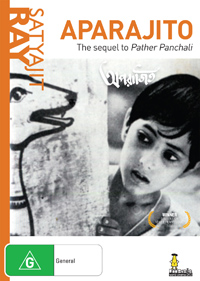Aparajito (The Apu Trilogy) (1956) |
|
Aparajito (The Apu Trilogy) (1956) |
|


|
| BUY IT |
| General | Extras | ||
| Category | Drama | Biographies-Crew-Satyajit Ray, Filmmaker (131 minute documentary) | |
| Rating |

|
||
| Year Of Production | 1956 | ||
| Running Time | 104:40 | ||
| RSDL / Flipper | Dual Layered | Cast & Crew | |
| Start Up | Ads Then Menu | ||
| Region Coding | 4 | Directed By | Satyajit Ray |
|
Studio
Distributor |
 Umbrella Entertainment |
Starring |
Kanu Bannerjee Karuna Bannerjee Pinaki Sengupta Smaran Ghosal Santi Gupta Ramani Sengupta Ranibala Sudipta Roy Ajay Mitra Charuprakash Ghosh Subodh Ganguli Mani Srimani Hemanta Chatterjee |
| Case | Amaray-Transparent | ||
| RPI | $29.95 | Music | Ravi Shankar |
| Video | Audio | ||
| Pan & Scan/Full Frame | Full Frame | Dolby Digital 2.0 (192Kb/s) | |
| Widescreen Aspect Ratio | None | ||
| 16x9 Enhancement | No | ||
| Video Format | 576i (PAL) | ||
| Original Aspect Ratio | 1.33:1 | Miscellaneous | |
| Jacket Pictures | No | ||
| Subtitles | English | Smoking | No |
| Annoying Product Placement | No | ||
| Action In or After Credits | No | ||
Aparajito (or The Unvanquished in Bengali) is the second film in the much critically-lauded series of films known as The Apu Trilogy by Satyajit Ray. The quality of the film stands on it's own, you don't need to have viewed Pather Panchali, the first film of the trilogy, released in 1955 to appreciate the struggles that Apu has to deal with in Aparajito as he develops from childhood to attending college. In between is his relationships with his family and the career expectations upon him to follow his father's footsteps and enter the priesthood. The events of the film are easy for western audiences to follow, which is one of the reasons why the film continues to receive critical praise fifty years after it's release.
If you have viewed Pather Panchali (check out fellow reviewer Trevor D's review here) prior to watching Aparajito, you would know that Apu's family leaves their ancestral village for Benares, where they live in relative poverty though Apu enjoys the freedom of exploring the new town. His father works as a priest by the river Ganges though the money he receives is not enough and Apu's mother, although happy to have left the village finds it hard to adjust to the crammed living conditions where neighbours live so close to each other.
This film surprisingly was a box office failure when released in India, unlike Pather Panchali. Perhaps the sad events of the film were the cause of this, thankfully Satyajit Ray was able to complete the trilogy in 1959 with the final film of the series, Apur Sansar (The World of Apu). This is the second release of the trilogy of films in Region 4 by Umbrella Entertainment after the release of Pather Panchali in 2008, hopefully Umbrella Entertainment will complete the trilogy of films by releasing Apur Sansar in 2010.
Aparajito won eleven international awards including the prestigious Golden Lion at the 1957 Venice Film Festival. It remains the only sequel to have won the top prize in the history of the event. The technique of 'bounce lighting' was also developed during the making of this film by cinematographer Subrata Mitra after an argument with art director, Bansi Chandragupta and director Satyajit Ray over simulating shadowless diffused skylight. He was adamant that it could not be done, but after reflecting upon the problem Mitra placed a framed painter white cloth over the set resembling a patch of sky and arranged studio lights below to bounce off the fake sky.
The aspect ratio of Aparajito is 1:33:1, full frame.
The film takes up 3.9gb of space on a dual-layered DVD with an average bitrate of 5.1 m/b sec. There are many film artefacts in the transfer including both positive (black) and negative (white) artefacts, lines across the image and telecine wobble. Overall, the film does not have compression issues though and the image does look better than the first film released by Umbrella Entertainment in The Apu Trilogy, Pather Panchali.
Subtitles in English are in white and are easy to follow.
There is no RSDL change because the film is presented on the first layer of a dual-layered DVD.
| Sharpness | |
| Shadow Detail | |
| Colour | |
| Grain/Pixelization | |
| Film-To-Video Artefacts | |
| Film Artefacts | |
| Overall |
The audio quality is similar to the Pather Panchali release. There is background hiss throughout the film, as well as clicks and audio dropouts at times.
The main soundtrack is in Bengali in Dolby Digital 2.0, encoded at 192 kbps.
Dialogue is clear and the audio is synchronised.
The music for the film was composed by Ravi Shankar. It is a traditional Indian music soundtrack with sitars and flutes featuring as the main instruments on the soundtrack.
There is no surround channel usage as the main soundtrack is in mono.
The subwoofer is not utilised either.
| Dialogue | |
| Audio Sync | |
| Clicks/Pops/Dropouts | |
| Surround Channel Use | |
| Subwoofer | |
| Overall |
NOTE: To view non-R4 releases, your equipment needs to be multi-zone compatible and usually also NTSC compatible.
Aparajito has been released in Region 1 in the United States and in Region 2 in the United Kingdom. The Region 1 release has no extras. The Region 2 has excerpts of an interview with Ray and some production notes by Ray's biographer Andrew Robinson. All releases of the film are similar in the video and audio quality.
Aparajito was named in Time Magazine's top 100 films in 2005 and continues to be critically lauded fifty years after it's release. This is a great film and well worth your time if you are willing to put up with the basic transfer of the film. The Apu Trilogy really requires a restoration equal to the work done on films such as Citizen Kane, Casablanca, Spartacus or Lawrence of Arabia for fans of world cinema to truly appreciate how good these films are.
| Video | |
| Audio | |
| Extras | |
| Plot | |
| Overall |
| Review Equipment | |
| DVD | Sony BDP-S550 (Firmware updated Version 019), using HDMI output |
| Display | Samsung LA46A650 46 Inch LCD TV Series 6 FullHD 1080P 100Hz. Calibrated with THX Optimizer. This display device is 16x9 capable. |
| Audio Decoder | Sony STR-K1000P. Calibrated with THX Optimizer. |
| Amplification | Sony HTDDW1000 |
| Speakers | Sony 6.2 Surround (Left, Front, Right, Surround Left, Surround Back, Surround Right, 2 subwoofers) |